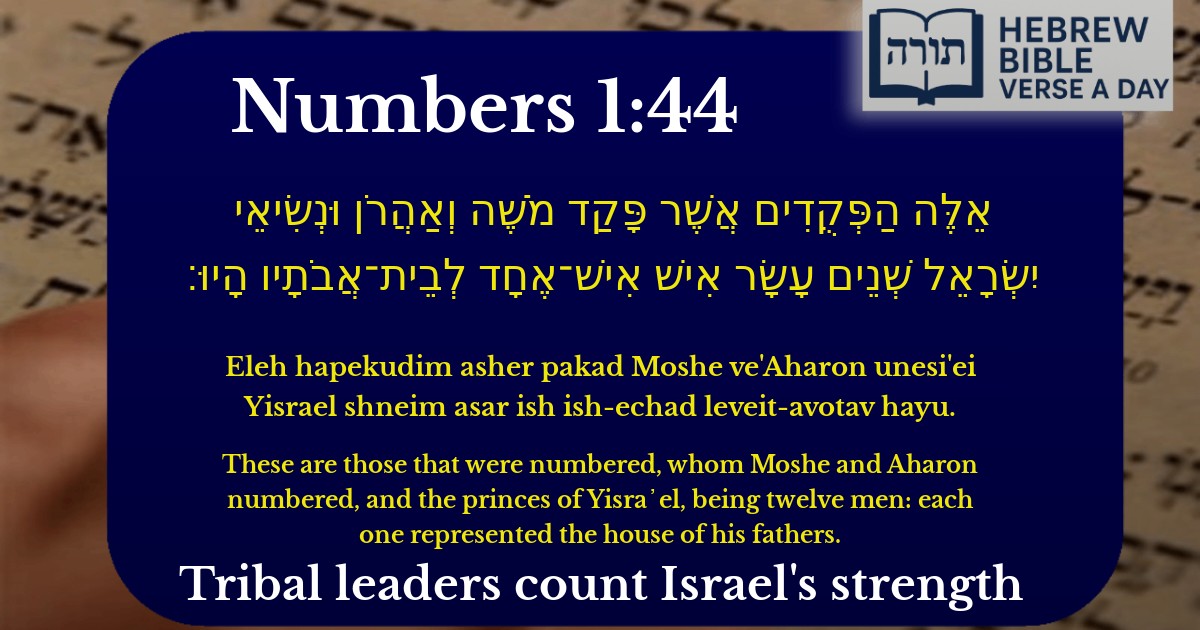Frequently Asked Questions
Q: What is the significance of the census in Numbers 1:44?
A: The census in Numbers 1:44 was commanded by Hashem to count the Israelites in the wilderness. According to Rashi, this counting showed Hashem's love for the Jewish people—just as one frequently counts their precious possessions. It also organized them for their journey and future roles, including military service and tribal responsibilities.
Q: Why were there twelve princes representing the tribes in the census?
A: Each of the twelve princes represented one of the twelve tribes of Israel, as mentioned in the verse. The Ramban explains that this ensured fairness and accountability, as each tribal leader was responsible for counting his own tribe. This structure also emphasized the unity and individuality of each tribe within the greater nation.
Q: What can we learn from the way Moshe and Aharon conducted the census?
A: The census was conducted with precision and dignity, as Moshe, Aharon, and the tribal leaders worked together. The Midrash teaches that this teaches us the importance of leadership with integrity—counting people respectfully and valuing each individual's role in the community.
Q: How does the concept of counting the Israelites apply to us today?
A: Just as each Israelite was counted in the desert, every Jew today has a unique role in serving Hashem. The Baal Shem Tov taught that no person is insignificant—every soul matters. This verse reminds us that we are all valued members of the Jewish people with a divine purpose.
Q: Why is the number twelve significant in this verse?
A: Twelve represents the twelve tribes of Israel, symbolizing the complete structure of the Jewish nation. The Talmud (Yoma 54b) explains that just as the twelve constellations guide the world, the twelve tribes each contribute uniquely to the spiritual mission of the Jewish people.


Context of the Verse
This verse (Bamidbar 1:44) concludes the census of the Israelites in the wilderness, detailing the role of Moshe, Aharon, and the twelve tribal leaders in counting the people. The counting was commanded by Hashem (Bamidbar 1:2-3) to organize Bnei Yisrael for their journey and military preparations.
Role of Moshe, Aharon, and the Princes
Rashi explains that Moshe and Aharon oversaw the census, while the twelve tribal princes (nesi'im) were directly involved in counting their respective tribes. The Ramban adds that this structure emphasized unity—each tribe had equal representation, with one leader per tribe, as the verse states, "each one represented the house of his fathers."
Significance of the Twelve Representatives
Why Specify "Each for His Father's House"?
Ibn Ezra explains that this phrase underscores the tribal lineage's importance—the census was organized by familial ties, not arbitrary divisions. The Kli Yakar adds that this preserved the unique spiritual role of each tribe, as Yaakov's blessings (Bereishit 49) designated distinct paths for each.
Lessons for Leadership
The Netziv (Ha'amek Davar) teaches that the collaboration between Moshe, Aharon, and the princes models effective leadership: central authority (Moshe), spiritual guidance (Aharon), and decentralized tribal representation ensured both unity and individual dignity.